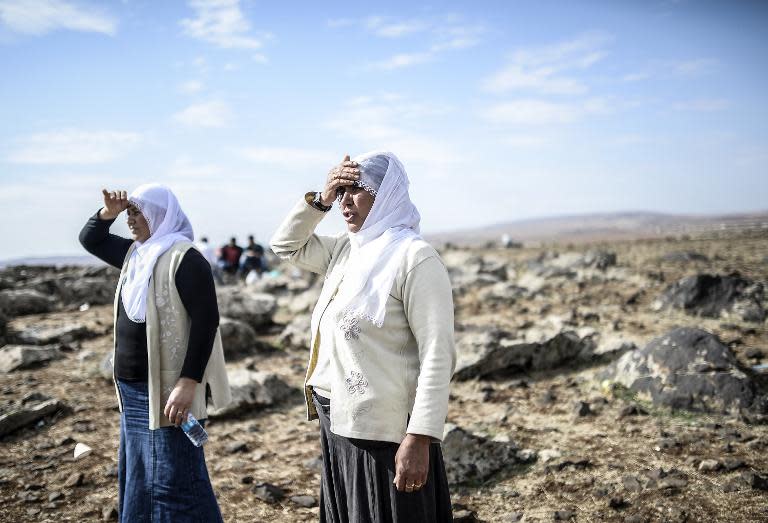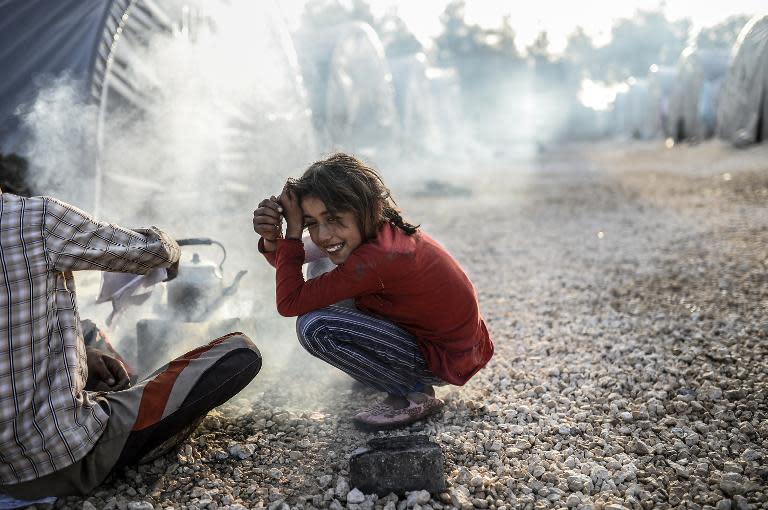Why Kobane is the Kurds’ Stalingrad and how ISIS fight like the Nazis
Stalingrad, whose successful defence saw the bloodiest battle of World War II and marked the turning point for the Allies, Kobane is every bit as symbolic
'We will resist to our last drop of blood together… If necessary we will repeat the Stalingrad resistance in Kobane.'
This bold statement of defiance by Polat Can, a Kurdish commander fighting ISIS jihadists in Kobane, echoes the hope that the northern Syrian town can emulate the Russian city’s heroic stand against the Nazis and force out a similarly brutal invader.
But, beyond the rhetoric, there are also compelling likenesses between the two sieges – albeit on vastly different scales - and the respective enemies at their gates.
Firstly, like Stalingrad, whose successful defence saw the bloodiest battle of World War II and marked the turning point for the Allies, Kobane is every bit as symbolic.
'While the city is of semi-strategic importance, Kobane – like Stalingrad – has assumed a far greater propaganda value,' says Justin Bronk, a research analyst in at the Royal United Services Institute in London.
'It has become a litmus test for both ISIS and the Kurds’ reputation and indicates which side can endure the longest in the battles ahead.
'And, while Stalingrad became a battle of personalities, Kobane has become symbolic of the greater fight between the West and jihadism'
In the case of Stalingrad, the city bore Soviet leader Joseph Stalin’s name and so Nazi dictator Adolf Hitler was determined to smash this emblem of communism in a battle of ideologies.
For ISIS, whose leader Abu Bakr al-Baghdadi wants to establish a strict Islamic Caliphate across Syria and Iraq, Kobane also represents everything they hate.
The massively outgunned Syrian Kurdish militia, the YPG, or People’s Protection Units, have long battled Islamic fundamentalism and introduced democracy in 2012 after becoming one of the first cities to wrest control from dictator Bashar Assad.
Many top figures in the Kurdistan Workers’ Party (PKK), a Marxist movement that is considered a terrorist group in both Turkey and the U.S., also have strong links with Kobane, which has been under siege for a month.
They include leader Abdullah Ocalan, who since 1999 has been jailed in Turkey, where half of all ethnic Kurds live, and acting boss Murat Karayilan.
Furthermore, capturing the city would give ISIS – or Islamic State as they want to call their nascent caliphate - a massive psychological advantage as the pro-Western Kurds have so far proved their most formidable enemy.


Kurds, who are predominantly Sunni Muslims like their fanatical enemy, live in four Middle Eastern countries – Turkey, Syria, Iraq and Iran – and have long struggled for a state of their own.
And they are determined to hold on to their territory.
'You are talking about a deeply motivated people who have fought one regime or another for more than 20 years and are extremely battle hardened,' adds Bronk.
'What they lack in training and weapons, they make up for in perseverance and morale – which is often the biggest factor in infantry engagements.
'In their sheer determination they certainly match the resolve of the defenders of Stalingrad to bleed their enemy white.'
Kurds are so committed to defending their homeland that women form a major part of their fighting forces, including their Peshmerga allies in northern Iraq.
Female fighters, who have even carried out suicide attacks, have partly joined the fray because they know the jihadists are brainwashed into believing that being killed by a woman will deprive them of martyrdom and the promised 72 virgins in the afterlife.
'We can say that the Kobane resistance is in particular a women’s resistance,' the YPG’s deputy commander Mayssa Abdo said recently – no doubt infuriating ISIS.

Yet, beyond these emotive issues, the decision to attack Stalingrad and Kobane were initially made for primarily strategic reasons.
In the case of the Russian city, which has now reverted to its pre-revolutionary name of Volgograd, it was the gateway to the Soviet oil fields in the Caucasus.
For ISIS, capturing Kobane would give them total control of nearly half of the 500-mile-long border between Turkey and Syria, which is a crucial route used by foreign fighters joining the group.
The jihadists, who launched their big offensive after their forces became bogged down in Iraq following the start of U.S.-led airstrikes in August, also want to clear away an effective opposition that has long tied up their troops.
For the YPG, if they can extinguish the ISIS attack, it could provide a springboard for a counter-offensive in Syria, providing they could muster up enough support.
This was the case following the Siege of Stalingrad, which ended in February 1943 after five months of fighting that ultimately led to 800,000 deaths.

'If the tables are turned at some point in the future, YPG will certainly look east towards Tel Abyad,' writes Middle East expert Carl Drott in a blog.
'The capture of this town would enable the isolated Kobane enclave to be connected with the much larger Jazira area that also borders the Kurdistan Region in Iraq (a successful attack would most likely come from this side).
'For ISIS, on the other hand, getting expelled from this area would mean losing all access to Turkey east of Jarabulus.'
And, as with encircled Stalingrad, Kobane’s defenders – surrounded by desert on three sides and unsympathetic Turkish forces just 200 metres north – have nowhere to hide.

The resisting militiamen, whose efforts have been bolstered in recent days by U.S. air attacks that have said to have killed 464 jihadists alone, also fear being massacred if they give up.
And, like Stalingrad, from which only 6,000 out of 330,000 German soldiers returned, local defiance has seen the attackers pay a far steeper price than they had expected.
Inside Kobane, the jihadists have been sucked into 'meatgrinder' street battles – again similar to Stalingrad, which was raised to the ground during its siege and turned into a dangerous labyrinth for hiding snipers.
Kurds, like the Siberian sharpshooters sent to Stalingrad and highlighted in the movie Enemy at the Gates, have proved themselves to be excellent marksmen.
At the same time, American and Arab warplanes are able to blow up ISIS positions and pick off their fighters from the sky.
Hitherto, ISIS had enjoyed lightning-fast advances by using similar military strategies to the Nazis.
'Their battlefield tactics are similar of the German Blitzkrieg campaigns in the early part of World War II,' says Bronk.
'They use fast, well-coordinated forces with vehicle support to attack enemy weak points in strength under the cover of long range artillery and mortar fire.'
Employing similar flanking manoeuvres to the German Wehrmacht, they have forced defending armies to retreat amid fear of their intense brutality, which has included a spate of beheadings and machine-gun massacres.
The Nazis, especially on the Eastern Front, shot prisoners, burned villages and used other terror tactics to magnify their military power.
'On a tactical level the other thing ISIS has in common with the Wehrmacht is its autonomous command structure, which has been very effective,' adds Bronk.
'German junior officers were encouraged to take the initiative – and so too have ISIS.'
Since June, ISIS have also plundered vast stockpiles of American heavy weapons from the retreating Iraqi Army – allowing them to emulate the German’s initial World War II advantage and become highly mechanised.
And, like the Nazis, who gained the support of Ukrainian nationalists and other anti-communists on the Eastern Front, ISIS have gained the loyalty of many local Arabs.
None of this has so far been decisive in Kobane, however, where more than 200,000 residents have fled but 10,000 determined Kurds have stayed on to fight.
'The sort of street-to-street meat grinder that Kobane has become does not play to ISIS’s strengths – and, rather more suits the lightly-armed Kurds,' says Bronk.
'Against an enemy with nowhere to retreat to and air support, a numerically limited force such as ISIS that normally relies as much on psychological effects as firepower to take ground faces a tough challenge.'
Yet, apart from scale, Stalingrad has one key difference: its saviour ultimately came when the Red Army were able to surround the German Sixth Army besieging the city.
A similar scenario could happen in Kobane, but at present this is unlikely.
Turkey, which has the biggest and best-funded army in the region, could easily encircle ISIS and crush the estimated 2,000 jihadists besieging Kobane.

But the country, which hosts 1.6million refugees from the Syrian Civil War, chooses not to because they are suspicious of the YPG after spending decades fighting their PKK allies.
The Americans and other Western states have also refused to put 'boots on the ground', although the option has been discussed.
Nevertheless, Turkey has recently opened its borders to Peshmerga fighters from Iraqi Kurdistan and Free Syrian Army soldiers from Aleppo so that they can reinforce Kobane.
Those Kurds currently holding ground in the much larger eastern Jazira region, which borders both eastern Turkey and northern Iraq, could also be reinforced and launch an attack with the aim of surrounding those laying siege to Kobane.
If they could reach the Euphrates River, which lies to the west of Kobane, they could close ISIS’s supply line and inflict a severe defeat on them.
While, this remains improbable, U.S. officials have stated that they believe Kobane is no longer on the brink of falling – a distant cry from the dire situation two week ago.
And, like Stalingrad’s odds-defying defence, perhaps Kobane’s guardians, who have already shown they are willing to make extraordinary sacrifices, can dare to hope.

 Yahoo News
Yahoo News 
